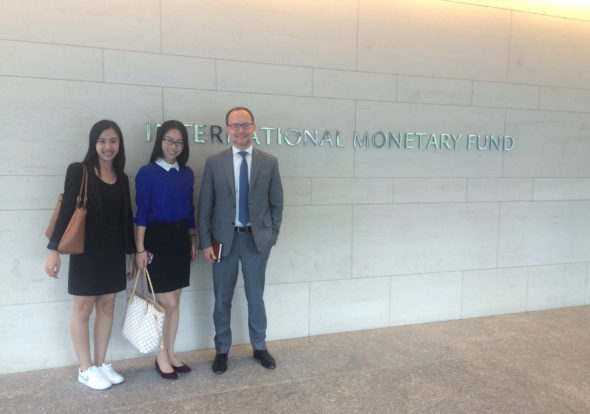May 26 marked the last day of the Global Master of Finance (GMF) immersion courses, and the DC portion will conclude with a full introduction and understanding of the role of Congress in financial regulation.
Our first speaker was a former member of congress; he took a unique angle – from a member’s point of view – to talk about how Congress gets involved in financial services. He started by describing a typical day of a member of Congress, to let us know how they look at financial institutions. It is surprising to know that for twenty years, he worked no less than sixty hours a week, and many times eighty or even a hundred hours. A member of Congress must try to be familiar with virtually every area that impacts their constituents, and spends most of the time meeting with constituents, going to committees, and getting involved in discussions in his or her areas of expertise.
Our speaker then talked about how Congress gets involved in financial services, which is primarily reactively. This means Congress usually does not get involved in financial services until there is some kind of crisis. Our speaker took the 2008 crash as an example, to illustrate how Congress and the Fed responded to maintain economic stability and set up a stimulus policy to resolve the world-wide panic when confronted with a financial crisis. We learned that for most members of Congress, regardless of party, they share a general philosophy to let the markets be markets, let people have the freedom to invest, and then try to set up some kind of safeguards to protect investors so that no one can take advantage of it.

Next, we took a tour of the US Capitol with a former US Congressman. He was a patient and knowledgeable person. During the tour, he introduced the history and some fun stories of the Capitol to us. He was also able to share some insights from a former Congressman’s perspective and an insider’s view.
We visited the original location of the Supreme Court, the Statuary Hall, the House Chamber, and the Speaker’s Lobby. The Statuary Hall, which is the Old House Chamber, displays statues of famous Americans. The most memorable part of the tour was the House Chamber. We were told to leave our bags, notebooks, phones, and other prohibited items in the Speakers’ Lobby before entering the House Chamber. The House Chamber is filled with rows of chairs. Our tour guide told us that the House of Representatives conducts legislative activities here. He also showed us his Congressman card that can be used to vote. When he voted, he would insert his card in a machine, and then would press the button of yes of no. Another interesting point is that in the House Chamber, which is part of the legislative branch, the President of United States can only enter via invitation, and does not sit in the highest chair. Instead, the President sits below the Speaker of the House within the House Chamber.

Then we went beneath the building. There was a very intriguing subway waiting for us, which took us to one of the Capitol office buildings. Our last speaker in Washington had experience in various political and financial areas. He has worked for a private equity firm, a hedge fund, and has participated in many kinds of economic policy settings. His experience itself is a good pattern that teaches us if someone in the finance industry would want to go further, finance knowledge is far from enough.
The speaker started from a very new view in the finance area: that the primary changes in finance always come from progress in technology. He stated that we can really feel the influences from blockchain and other kinds of FinTech rising to the next level. The young generations should pay more attention to it and explore more possibilities in this field. He then spoke about regulation.
Over-regulation is now a hot topic, but he emphasized that over-regulation is at least good for common consumers. He also mentioned that the Fed, SEC, and other regulatory authorities are trying to shorten the regulatory lag, which can seriously impact the effect of policies. One more interesting thing he told us is that any authority still can be wrong. He told us that one high-level person in the Fed considered the mortgage market healthy just before the global financial crisis. What we learned from this speaker is that although we are young now, we should always keep questioning what authorities say and do, and maintain the courage to challenge their voices, and that will help us to contribute more in the finance industry in the future.
We the GMF 2017 cohort are very grateful to have had the chance to learn about the US financial markets and regulation with the insightful speeches from the distinguished practitioners and field trips. This two week immersion course will definitely give us a holistic and deeper understanding of today’s global financial markets and will set the tone for our future studies and careers after graduation.
Guest Bloggers: Shuying (Sunnie) Li, Kedi (Kelly) Ni, Yao (Deborah) Shan, Lei (Isaac) Xia (GMF 2017)
This is a series of blogs chronicling the experiences of 42 Global Master of Finance (GMF) dual degree students during their two week immersion course in New York and Washington, DC. Each blog will be written by a small subset of students during their experience. Names of speakers and presenters at firms are anonymous at the request of the firms and course organizers.




 Our morning session on May 26 kicked off with Jason Gould and Richard Choi, two inspiring speakers from Carlton Field Jorden Burt. Carlton Fields is a leading provider of legal and consultation services, mostly to financial institutions, offering solutions to compliance systems and fighting for clients in court. They described the necessity of regulation and the degree of regulation that will protect the industry as well as avoid burdening the business. After various meetings with legislative representatives, we complete our tour in D.C. by hearing from the other side of the aisle. We saw their passion and commitment to speak for regulation objectives and represent their interests. Regulation and legislation together make the financial industry healthy and secure.
Our morning session on May 26 kicked off with Jason Gould and Richard Choi, two inspiring speakers from Carlton Field Jorden Burt. Carlton Fields is a leading provider of legal and consultation services, mostly to financial institutions, offering solutions to compliance systems and fighting for clients in court. They described the necessity of regulation and the degree of regulation that will protect the industry as well as avoid burdening the business. After various meetings with legislative representatives, we complete our tour in D.C. by hearing from the other side of the aisle. We saw their passion and commitment to speak for regulation objectives and represent their interests. Regulation and legislation together make the financial industry healthy and secure.


